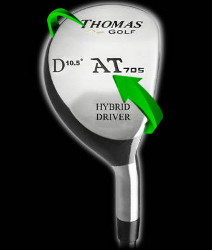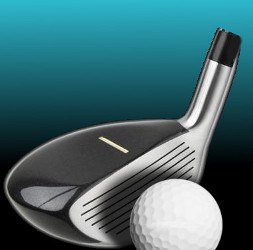
Club tested: Thomas Golf AT705 Hybrid Mini Driver
Club specs: Hand – Right; Loft – 10.5°; Lie – 56°; Length – 43.5”; Shaft – Graphite, “S” (stiff) flex
Price as tested: $139 (regularly $238)
About Thomas Golf products: All equipment made by Thomas Golf features the company’s patented Shot Accuracy Technology, an alignment indicator on the top of the club which helps assure precise aim. The company offers free custom fitting of all clubs on its website and sells its products exclusively online.
Club notes: In tandem with the AT725 Square Hybrid Driver, the AT705 model is Thomas Golf’s bid to offer a different kind of driver. With its (relatively) small clubhead and shorter-than-standard shaft, the club is something of an antidote to the long, monster-headed drivers currently dominating the market.

We tested the AT705 with standard specs for loft, length and lie, with the company’s Ultralite – Low Torque graphite shaft (60 grams) in Stiff flex. Thomas also offers Regular (R) and Senior (A) versions of the shaft; a steel option is available as well.
At address: If you’re one of those golfers who’s never gotten used to looking down at an enormous clubhead, the AT705 will please your eye. At 230cc (cubic centimeters), the head is just half the size of the maximum volume allowed by golf’s rules. And, as its name suggests, it’s built like a hybrid – pretty and pear-shaped, inviting rather than intimidating.
Setting up squarely is a cinch. The alignment aid and flat crown are Thomas Golf’s calling cards, and they definitely foster confidence at address.
One additional note about the club at setup: Because it’s slightly shorter than a standard driver, the company recommends a ball position of an inch or two inside the left heel, similar to a 3-wood. More on this in a moment.
Swinging it: Remember how it felt to swing first-generation oversized drivers? The AT705 is like that, only in reverse. Though it’s actually bigger than Callaway’s original Big Bertha – can you believe it was only 190cc? – the AT705 feels refreshingly small compared to today’s typical driver. It’s more like swinging a hybrid, which was exactly what Thomas was going for in designing the club.

At impact: Sweet. The AT705 Hybrid Driver feels quite flush on center contact, without the metallic, window-rattling “clang” of some 460cc models. The high-modulus graphite shaft and Thomas Golf’s proprietary compound grip dampen miss-hits while providing adequate feedback.
Ball in flight: Our tester, a mid-handicapper, noted that you don’t have to catch the AT705 Hybrid Driver near the top of the clubface to produce nice, high tee shots. (Nor do you need skyscraper tees to hoist the ball high enough to get it airborne.) In fact, he was able to vary trajectory, without changing his swing, by simply teeing the ball lower or higher.
Back to the earlier point about ball position. We experimented with a variety of position, from off the left heel to several inches inside the heel. Best results were produced by a position just a little right of a standard driver, where the club naturally bottoms out. We suggest spending some range time determining a spot that works best with your swing.
Playability & forgiveness: Better golfers will appreciate the AT705 Hybrid Driver’s playability. For starters, it’s much easier to hit a draw with this club than with a standard-sized driver. Conversely, the 10.5° loft and shorter shaft seem to take some of the curve off slices.
Here’s the kicker: Our mid-handicapper was able to hit the AT705 “off the deck,” placing several balls on the ground, sans tee, and getting most of them airborne. Try that with your 460cc, 9° model.
Bottom line: The AT705 Hybrid Driver is an interesting concept that works in real life. We’d even consider adding it to the set as a second driver – especially on courses with tight fairways or long par 5s – or as an alternative to our regular “gamer” when conditions call for precise control. At just $139 when tested in April 2013, and a steal even at the full retail price of $238, it’s affordable enough to grab one and experiment. This club has “secret weapon” written all over it.






